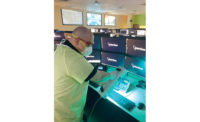Just as there are a number of things that qualify as “video monitoring” — from verified video to guard tours and more — there are equally varied ways that dealers have found success in providing video monitoring services to their customers.
While some choose to specialize only in video, becoming experts and even offering those services to other dealers, others outsource the monitoring and focus on selling the solution. SDM spoke with five dealers who are currently offering video monitoring to find out how and why they got into it, what challenges they faced and what lessons they can impart to others.
Rapid Security Solutions Leaves the Complex Services To Third-Party Monitoring Centers
While Rapid Security Solutions, Sarasota, Fla., does video verification tied to intrusion systems that is just a small part of what they offer says Steven E. Paley, president and CEO. “The larger part is our interactive video monitoring services. We are doing all types of video monitoring with analytics and two-way audio for managing areas of businesses or commercial spaces that are typically trying to prevent people from intruding.” The company also offers interactive video guarding services, he says.
All of these more complex services are monitored by third-party partners, he adds. “We only use third-party monitoring [for video].”
It is one that has really started to take off for the company, particularly in the last year and a half, Paley says. The business is growing 25 percent to 30 percent or more per year now, Paley says. “The profitability on these types of services is high — well north of 50 percent.”
However, even with outsourcing the monitoring, there were still challenges. “It took a while to perfect the technology,” Paley says. “Often it looks great until you start actually integrating it. It also took a while to find a quality third-party monitoring partner that could properly manage it.”
Paley found his solution by using a few different monitoring centers: Acadian Monitoring Services, Tech Wave and Rapid Response Monitoring Services. “Depending on the need we use whichever one has the best solution,” he says.
With rapid technology advances, Paley feels some of the challenges he faced are already going away for those just getting into it now.
“I think for people starting down this path now, as opposed to five or six years ago, the technology is more solid. A lot of the mistakes we made, we made so others don’t have to.”
Finding the Right Platform Was Key for Allstate Security Industries
Allstate Security Industries Inc., Amarillo, Texas, offers “all aspects” of video monitoring, says president and CEO Randall Renfroe — up to and including drones. “We are able to do video guard tours, verified look-ins, alarm triggers, anything we can to better help the local authorities have better information,” he says.
Allstate has been offering video monitoring for seven years, but recently changed monitoring platforms to offer better service, Renfroe explains. “We have been trying to find a better platform for a long time and about three months ago signed up with I-View Now. We are very happy with what they have offered us. It is tremendous to find something that does everything you need and is very stable.”
Renfroe and his company went through some growing pains to find that, he says.
“At first we were just trying to get our first client. Then once we had three or four we could show them how we could help them cut down on false alarms, and business started picking up. But because the companies providing the equipment for this had died off, we were trying to find a new platform. We figured we would have to do it a different way. About five years ago we decided to use all the different software in-house. It was very difficult to keep up with all that so then we decided to switch to I-View Now and make our lives easier.”
Despite all the changes, the growth in video monitoring has been “crazy,” Renfroe reports. “We will have probably around 500 sites before the end of the year. That is a really good sign.”
Training varies depending on the type of monitoring — with the most rigorous being drones due to FAA requirements — but Allstate cross trains the other operators. “We have people on shifts,” he says.
“Training is the most difficult thing because they need to make sure they keep their eyes peeled. There are a series of events to make sure it is handled properly.”
Renfroe’s program has been such a success he is actually getting calls from competitors, he reports. “I am offering this to others, as well. Even my competitors are talking to me about doing it for them because they realize how big a deal this is. We monitor in Dallas and Ft. Worth, and they are asking for video verification. Other companies will need someone to do that for them. A lot of the other monitoring centers aren’t doing it yet or are not set up with local law enforcement. By the end of the year I hope to have all PSAPs in all seven states we are in set up with us so we are able to push the video.”
This success was hard won, however. Looking back, Renfroe says, he would do things differently. “Triple check the manufacturer. Make sure that you are really doing due diligence on what they can do and make them show you that it works. I made a big mistake twice in signing up with the wrong people.”
(Visit www.SDMmag.com/ drones-in-security for more on the drone video monitoring program.)
Kastle Systems Initially Acquired Its Video Monitoring Expertise
Like much of what it has done in its history — including pioneering managed access control in the 1970s— when it came to offering video solutions SDM’s 2015 Systems Integrator of the Year Kastle Systems, Falls Church, Va., chose to find a way to do it in-house, in this case by acquisition. Accordingly in 2013, Kastle Systems purchased Check- Video, a hosted-video-platform company. The company offered videoverified alarms. Then, in 2017, it purchased Urban Alarm, which provides real-time remote guard services through video.
“Video monitoring is a broad term that can be interpreted and applied many different ways,” says Dave Fisher, Kastle’s vice president and general manager, remote video monitoring. “We do a fair amount of video guarding [as well as] verified video.”
Fisher says the video guarding is particularly attractive to certain customers. “Typically a guard will cost somewhere between 5,000 to $8,000 per month for after-hours and weekends. Video guarding is a small fraction of that.” The video portion of Kastle’s offerings is growing very well, Fisher says. “The value proposition is compelling…. Video in general is becoming a bigger part of Kastle as a percentage and video guarding is a rapidly growing component of that. We have essentially nearly doubled the size of our staff around that.”
Yet Fisher cautions that video services, whether something as intensive as video guarding or more “routine” video verification, are not something that should be done lightly. Kastle uses a different set of employees to accomplish its video monitoring than for other types of monitoring, he explains. “Typically monitoring operators are very binary: the signal comes in, they look at the event and they follow instructions to make appropriate notifications and dispatches. Video requires a special skillset. You are asking an operator to interpret a scene and sometimes make judgement calls. We found not only is there a heavy technology lift, but from the operations center perspective we went the route that you need a whole video monitoring group with different skillsets.”
He advises anyone looking to get into video monitoring to calculate the cost of doing so. “Make sure you have a good handle on what it is going to take internally and externally to be able to actually deliver this service and do it well. There is demand for it and the value prop can be very strong; but it is not a casual undertaking.”
Research & Testing Was a Key to Success for YourSix
Jacob Hengel, chief technology officer, YourSix, Minneapolis, was caught off-guard by how successful his company’s video monitoring offering would become. “Our core focus is video surveillance in the cloud,” he says. “We always knew video verification would be a part of the business but when we signed up with Axis Communications to be a partner with their Guardian solution I had no idea it was going to blow up and be such a large part of our business.”
When YourSix launched its cloud surveillance program about five years ago, the focus was on saving hardware by cutting out NVRs, Hengel recalls. “It wasn’t long after that we started getting more and more requests [for video verification and monitoring]. We have gone from trying to fulfill that customer need to proactively talking with almost every client now.”
It has also gone beyond verification. “The basic thing people think of with video monitoring is the traditional alarm system triggering a video event,” Hengel says. “We take it further. We do tours at regular intervals, video check-ins. Some organizations have specific times they know problems are likely to occur. My personal favorite is we do a lot of analytics integration, with audio and video events that trigger that — whether it is aggression [detection] or gunshot detection. We discuss what the client’s business needs are and find the balance between the budget and turning from a reactive alarm model into a proactive one.”
While he may have hit on it accidentally, that doesn’t mean there wasn’t research involved, Hengel adds. “When we started seeing demand, we had to take a step back. We knew it would be a part of our business, but we didn’t realize it would be a core part. I attended a variety of events, met with dozens of vendors and heard their success stories, and even talked with some that had left the space because they didn’t have success. That was a big part of how we positioned ourselves to get into this space. We were already doing cloud solutions, and joining the Axis community was pivotal to our success. From there we met with companies about integration with the cloud and into the central stations.”
YourSix relies on a third-party company, which worked with the company’s software partner to write an integration between the cloud and the central station, Hengel explains. With some mergers the company has done over the past couple years, it now has more than 2,000 accounts, he says. “It is growing immensely. The first years we only had five percent of our clients doing video monitoring. At the end of this year our goal is to hit 30 percent of our active clients.”
In hindsight, Hengel says he was almost too cautious when it came to getting into video monitoring. “I was pretty skeptical of how efficient and accurate it could be. I wish I had put more time into it sooner, now that I have seen the success. As long as you are testing before anything goes live and verifying every possible situation, there can be a lot of success in it. Video brings new excitement and solutions to the alarm industry and that is huge.”
Specialized Knowledge Is a Requirement, Says Veteran Viewpoint Monitoring
Viewpoint, Lowell, Mass., was started in 2005 for the express purpose of doing video monitoring, says CEO Brad Gordon. “We are a remote video monitoring company and we offer pretty much all the video monitoring services that are available. We do audits using camera systems and analytics, conduct video patrols, and do event-driven monitoring.”
In recent years Gordon says he has seen more competition, but as a full-service video monitoring company he hasn’t felt any threat. “We are one of the few companies that know how to offer and provide the virtual guarding services, patrolling using CCTV and following clients’ detailed protocols. Most of the competition is simply responding to alarms or motion sensors on-site and acting as a central station. We are actually doing the work of a security officer at times. We also design and install the camera systems using our integrator partners.”
Because of the wide variety of video monitoring the company does, Gordon stresses it does require specialized knowledge. “This is very labor intensive. Our monitoring agents are required to have two weeks of classroom training before they can ever step foot on the floor.”
While there are things he wishes he had understood when starting out, he says he is not sure it would be the same today. “It has become widely accepted as a viable security product and many of the large guard companies have now begun offering it, understanding that is what their clients are looking for. The biggest change has been the field of video analytics, which are getting smarter…. It makes it easier for others with limited services, particularly video verification.
“Viewpoint was definitely a pioneer in the whole video and voice monitoring area,” he adds. “We have been doing it for 13 years and we pioneered a lot of the techniques and some of the equipment…. People today are hesitant to try new things. It helps to understand the client’s business needs and sell them what they want.”




